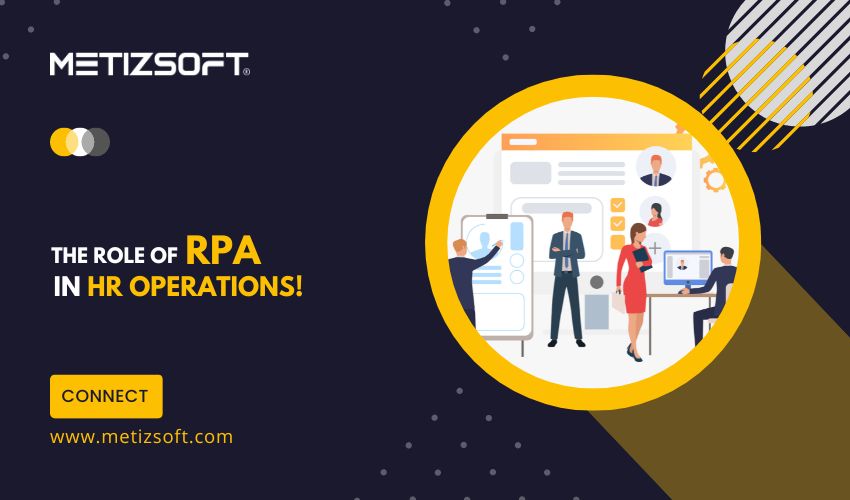
The Human Resources (HR) department is a crucial business component. It manages all aspects of an employee’s life cycle, from initial sign-up to exit management. However, due to the complex processes and tasks involved, providing timely resolution can be challenging for the HR service desk. Consequently, many companies, regardless of size and industry, have begun automating solutions into their existing systems to eliminate obstacles and reduce costs.
Organizations can improve their HR team’s burden and make it more efficient by implementing automation solutions such as robotic process automation (RPA), which streamlines transactional HR tasks.
In this post, we will discuss everything you need to know about using RPA in human resources and payroll. We will cover the benefits, use cases, and best practices to successfully implement RPA in HR.
Table of Contents
Describing RPA in the HR Operations!
Robotic process automation, or RPA, effectively enhances HR departments’ data management capabilities. RPA involves software bots that automate rule-based, highly transactional processes that require little or no human intervention.
Specifically, in HR operations, RPA primarily involves using software robots to perform high-volume, repetitive tasks, typically for HR employees. These tasks include, but are not limited to, onboarding new hires, processing payroll, benefits enrollment, and compliance reporting, which require significant manual and repetitive labor. RPA can lead to increased accuracy and speed of data processing and can help reduce overall HR-related costs.
Top RPA Use Cases for Human Resources!
RPA is undoubtedly a valuable tool for the human resources department. It simplifies various work processes and empowers the HR team to handle significant administrative tasks without recruiting additional staff.
Here are some of the most common and practical uses of RPA in human resources:
CV Screening & Shortlisting — Software robots powered by RPA technology can simplify the hiring process by collecting and comparing job applications against predefined rules. Qualified candidates receive interview notifications, while others receive rejections. This saves ample time and effort for HR teams and improves overall efficiency.
Employee Onboarding — Onboarding new candidates is a complex and time-consuming task involving collaboration among several individuals to synchronize data from multiple systems. Specifically, this includes creating user accounts, allowing access to applications, providing IT equipment, and creating email addresses.
However, RPA automates onboarding by activating a template for user accounts. In this way, robots make rule-based decisions, send documents, and assign authentications. Consequently, this streamlines the process, reducing the need for manual intervention.
Leave/Attendance Management — RPA simplifies the time-consuming task of managing employees’ attendance and leaves. It can verify leave balances, update records, and generate attendance reports, minimizing errors and facilitating payroll processing.
Training Management — RPA tech automates induction. After applying, new candidates get a digital profile. RPA software updates new hires on business processes, compliance standards, and regulations. Coupled with e-learning, RPA-based induction improves training.
Payroll Processing – Payroll processing is a vital HR task, but it involves a lot of repetitive work that can lead to errors. RPA in HR can simplify the process by collecting and connecting data between multiple systems, reducing the risk of errors.
RPA bots verify employee hours and correct discrepancies. Software robots generate reports that simplify payroll processing by highlighting overtime, missing hours, or excessive time usage.
Data Management – Managing employee data is a crucial aspect of HR functions. It involves systematic and consistent actions across multiple databases containing various data formats. These databases can range from payroll and employee benefits to company regulations.
RPA can simplify employee management tasks and help minimize the risk of data entry errors. Additionally, robots can perform data cleansing tasks regularly to ensure data consistency across multiple databases.
Performance Management — Organizations across various industries always look for ways to use RPA in their HR departments to enhance performance HR management systems. RPA helps HR teams manage tasks like employee goal setting, incentives, and rewards. It makes performance management more efficient, reduces errors, and saves time.
Employee Offboarding — Efficient employee offboarding is as crucial as onboarding. HR managers must handle multiple tasks during the exit process, including generating exit documents, revoking system access, and settling final dues to avoid audit flags.
RPA in HR can automate the offboarding process by capturing relevant details from the employee’s report and updating them in the finance app for validation. It can also notify the concerned department via email.
Benefits RPA brings to the HR Operations!
Implementing RPA in an organization’s Human Resources department can reduce time spent on repetitive tasks. This automates and allows HR managers to focus on more critical and strategic tasks that can contribute to the company’s growth.
RPA primarily targets smaller tasks and integrates all the processes previously accessed by legacy systems. Here are some benefits RPA brings to the HR operation process:
Consistency — HR departments can rely on RPA to complete tasks with perfect replication and improve the company’s performance, ensuring consistent output.
Enhances Accuracy — RPA technology is pre-coded, minimizing errors. It contributes to the company’s strategic goals and productivity by enabling staff to focus on high-value tasks.
Scalability — When executed on a large scale, the cost per task or effort on RPA is significantly low and can be easily adjusted accordingly. This results in minimal effort waste and makes the system highly efficient.
Reliability — RPA eliminates the need for manual intervention in repetitive processes. This means that automation bots can work continuously without taking breaks, getting tired, or experiencing downtime.
In addition, they offer highly accurate results every time they process new data. This level of reliability provides HR and Payroll professionals with a stress-free work experience.
Wrapping Up!
The Grand View Research, Inc. comes with a report that the global market for robotic process automation is expected to grow at a CAGR of 39.9% from 2023 to 2030, with a projected market size of USD 30,850.0 million by 2030.
The potential of robotics in Human Resources is proliferating and encompasses a wide range of organizational functions. Implementing Robotic Process Automation in HR can improve accuracy and significantly reduce labor and processing time, ultimately resulting in higher satisfaction levels among employees and customers. RPA offers innovative solutions to HR processes that transform the way operations are conducted.
Hire RPA Experts from a renowned RPA Development Agency to ensure the smooth implementation of robotic process automation in your existing HR system.
AboutManthan Bhavsar
Related Posts
RPA in Healthcare – Role, Use Cases, Challenges and Benefits!
In a rapidly multiplying digital era, one industry that genuinely deserves to be completely automated is none other than the...
RPA Role & Impact in the Logistics & Transportation Industry!
In a rapidly growing and competitive era of technology, every other company and business is streamlining their business...

